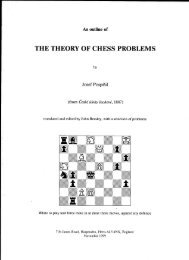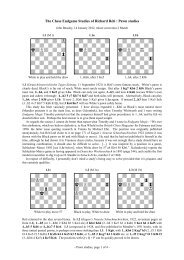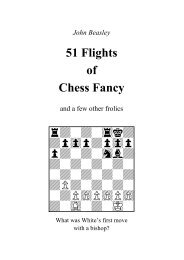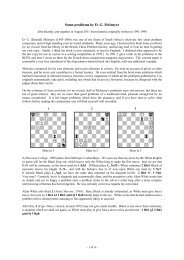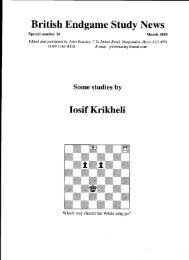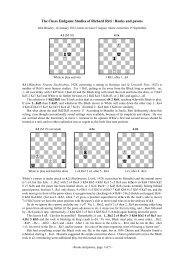A tribute to G. W. Chandler - John and Sue Beasley
A tribute to G. W. Chandler - John and Sue Beasley
A tribute to G. W. Chandler - John and Sue Beasley
Create successful ePaper yourself
Turn your PDF publications into a flip-book with our unique Google optimized e-Paper software.
<strong>Ch<strong>and</strong>ler</strong> as composer 5<br />
I have quoted none of them here. There was a series of technical essays in which<br />
the complete removal of a free Black queen would allow several different mates<br />
but each of its actual moves only allows one; one of them even received a first<br />
honourable mention in a BCF <strong>to</strong>urney, but they were dreary things <strong>and</strong> again none<br />
appears here. And there was another series of essays in which an apparently<br />
important man has in fact <strong>to</strong> be got out of the way <strong>and</strong> no use is made of it in the<br />
subsequent proceedings. On the face of it, this is an entirely legitimate<br />
compositional idea, but the actual problems are disappointing <strong>and</strong> the theme<br />
appears <strong>to</strong> require more than two moves for its full effect. (A classic example was<br />
published by Auguste d’Orville in 1842: wRb3, Nd5/e6, Pb2, bKa4, Nb5, mate in<br />
four. It is natural <strong>to</strong> expect the White rook <strong>to</strong> play a major part in the proceedings,<br />
but in fact it is merely an obstacle, <strong>and</strong> if we get rid of it by 1 Rb4+ Ka5 2 Ra4+<br />
Kxa4 we then have a simple mate in two.) I originally shortlisted one of these<br />
problems in order <strong>to</strong> illustrate the series, but it was so far short of <strong>Ch<strong>and</strong>ler</strong>’s best<br />
work that I eventually decided <strong>to</strong> omit it.<br />
One might have expected the matter <strong>to</strong> end here, but early in 1971 there was a<br />
postal strike, <strong>and</strong> the enforced holiday from BCPS administrative work gave<br />
<strong>Ch<strong>and</strong>ler</strong> an opportunity <strong>to</strong> get out his board again. This was <strong>to</strong> spark off something<br />
of an Indian summer, <strong>and</strong> some fine problems date from this final decade.<br />
They were generally reworkings of old ideas <strong>and</strong> anticipation <strong>to</strong>ok a <strong>to</strong>ll, but they<br />
were deservedly well received by solvers. If the mind slows with age, the skills it<br />
has acquired remain as long as bodily health can support them.<br />
Such were the two-movers. There are 21 in this selection, six from 1909-18,<br />
nine from 1945-58, <strong>and</strong> six from 1971 onwards.<br />
<strong>Ch<strong>and</strong>ler</strong>’s three-movers were in quite a different style. Apart from an early<br />
single-line problem based on the “Indian” theme (a White man retreats so that<br />
another man can cut its line, allowing the Black king <strong>to</strong> move on <strong>to</strong> this line),<br />
all but the last three were in the “Bohemian” style in which the interest lies in<br />
a blend of “model mates” in different varations, <strong>and</strong> even the early Indian problem<br />
ended in a model mate. (A “pure” mate is one in which each square in the Black<br />
king’s field is barred <strong>to</strong> him in only one way, either by being occupied by a Black<br />
man or by being guarded by a single White man, <strong>and</strong> an “economical” mate is one<br />
in which all the White men apart perhaps from the king <strong>and</strong> the pawns take part;<br />
a “model” mate is both pure <strong>and</strong> economical. One concession is permitted, though<br />
few of <strong>Ch<strong>and</strong>ler</strong>’s problems take advantage of it: the pinning of a Black man in<br />
the king’s field does not count as an offence against purity, even though this<br />
square is necessarily guarded as well as blocked.)<br />
By Bohemian st<strong>and</strong>ards, most of these problems were competent without<br />
being outst<strong>and</strong>ing. It is easy for a Bohemian problem <strong>to</strong> become a mere shapeless<br />
agglomeration of pretty mates, <strong>and</strong> the <strong>Ch<strong>and</strong>ler</strong> principle that the pieces should<br />
alternate mating <strong>and</strong> guard duty does nothing <strong>to</strong> combat this shapelessness. There<br />
are in fact two ways in which it can be avoided: by echoing similar mates in<br />
different variations, which conflicts with the principle that mating <strong>and</strong> guard duty<br />
should alternate, or by linking the variations strategically. The latter is not easily



